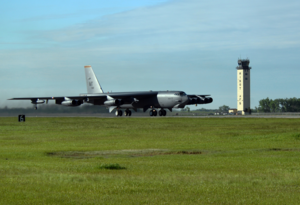
The 5th Bomb Wing is a United States Air Force unit assigned to Air Force Global Strike Command's Eighth Air Force. It is stationed at Minot Air Force Base, North Dakota. The wing is also the host unit at Minot. The 5 BW is one of only two active duty Boeing B-52H Stratofortress wings in the United States Air Force, the other being the 2nd Bomb Wing at Barksdale Air Force Base, Louisiana. Also, stationed at Barksdale Air Force Base, and operating the B-52H is a third unit, the 307th Bomb Wing, which is part of the Air Force Reserve Command.

The 95th Reconnaissance Squadron is a squadron of the United States Air Force. It is assigned to the 55th Operations Group, Air Combat Command, stationed at Offutt Air Force Base, Nebraska. The squadron is equipped with several variants of the Boeing C-135 aircraft equipped for reconnaissance missions.
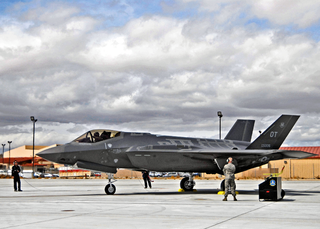
The 31st Test and Evaluation Squadron is a United States Air Force unit, assigned to the 53d Test and Evaluation Group, stationed at Edwards Air Force Base, California as a geographically separated unit of the 53rd Wing. The 31 TES is an Air Combat Command (ACC) tenant unit at Edwards, providing personnel to support combined test and evaluation on Air Force weapons systems.

The 20th Bomb Squadron is a unit of the 2d Operations Group of the United States Air Force located at Barksdale Air Force Base, Louisiana. The 20th is equipped with the Boeing B-52H Stratofortress.

The 28th Bomb Squadron is a squadron of the United States Air Force. It is assigned to the 7th Operations Group, Global Strike Command, stationed at Dyess Air Force Base, Texas. The squadron is equipped with the Rockwell B-1B Lancer.

The 93rd Bomb Squadron, sometimes written as 93d Bomb Squadron, is a squadron of the United States Air Force Reserve. It is assigned to the 307th Operations Group of Air Force Reserve Command, stationed at Barksdale Air Force Base, Louisiana. The squadron is equipped with the Boeing B-52H Stratofortress, and is the Air Force's B-52 Formal Training Unit (F.T.U.).
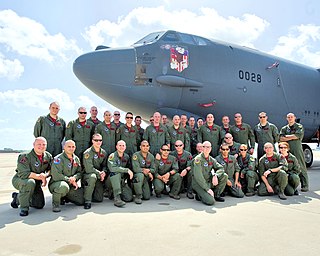
The 96th Bomb Squadron is a unit of the United States Air Force 2d Operations Group located at Barksdale Air Force Base, Louisiana. The 96th is equipped with the Boeing B-52H Stratofortress.

The 5th Reconnaissance Squadron is part of the 9th Reconnaissance Wing, assigned to Beale Air Force Base, California. It is stationed at Osan Air Base, South Korea as a Geographically Separated Unit (GSU). The squadron is the fifth oldest United States Air Force squadron, its history dating to 5 May 1917 as the World War I 5th Aero Squadron.

The 99th Reconnaissance Squadron is a squadron of the United States Air Force. It is assigned to the 9th Operations Group, Air Combat Command, stationed at Beale Air Force Base, California. The squadron is equipped with the Lockheed U-2 Dragon Lady reconnaissance aircraft.

The 32nd Air Refueling Squadron is part of the 305th Air Mobility Wing at Joint Base McGuire-Dix-Lakehurst, New Jersey. It operates the Boeing KC-46A Pegasus aircraft conducting air refueling missions. The squadron is one of the oldest in the United States Air Force, its origins dating to 19 May 1917, being organized at Camp Kelly, Texas. The squadron deployed to England as part of the American Expeditionary Force during World War I. During World War II, the squadron saw combat service as a Boeing B-17 Flying Fortress unit, assigned to the Fifteenth Air Force in Italy. During the early years of the Cold War, it was a Boeing RB-47 Stratojet strategic reconnaissance squadron as part of Strategic Air Command.

The 72d Test and Evaluation Squadron is part of the 53d Wing at Eglin Air Force Base, Florida. The squadron is geographically separated but is operated from Whiteman Air Force Base, Missouri. It conducts testing and evaluation of the B-2 Spirit aircraft.

The 429th Attack Squadron is a classic associate squadron, stationed at Holloman Air Force Base, New Mexico. It is geographically separated from its parent 926th Wing at Nellis Air Force Base, Nevada.

The 49th Test and Evaluation Squadron is an active United States Air Force unit. Its current assignment is with the 53d Wing, based at Barksdale Air Force Base, Louisiana.
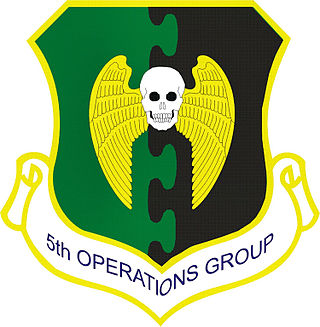
The 5th Operations Group is an operational component of the United States Air Force 5th Bomb Wing, stationed at Minot Air Force Base, North Dakota. Its mission is to manage and operate B-52H Stratofortress bombers serve as part of the Air Force's conventional and strategic combat force.

The 489th Attack Squadron is an active United States Air Force unit, stationed at Creech Air Force Base, Nevada, and operating MQ-1 and MQ-9 unmanned aerial vehicles. It was active at Beale Air Force Base, California as the 489th Reconnaissance Squadron from 2011 to 2015.

The 718th Bombardment Squadron is an inactive United States Air Force unit. It was last assigned to the 4128th Strategic Wing at Amarillo Air Force Base, Texas, where it was inactivated on 1 February 1963.

The 717th Bombardment Squadron is an inactive United States Air Force unit. It was last assigned to the 4245th Strategic Wing at Sheppard Air Force Base, Texas, where it was inactivated on 1 February 1963.

The 322d Expeditionary Reconnaissance Squadron is a provisional unit of the United States Air Force, assigned to Air Combat Command to activate or inactivate as needed.
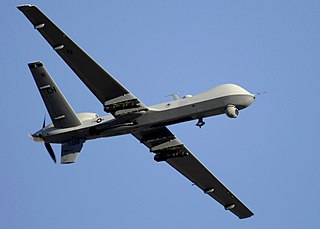
The 324th Expeditionary Reconnaissance Squadron is a provisional United States Air Force unit. It is assigned to the 409th Air Expeditionary Group at Naval Air Station Sigonella, Italy.
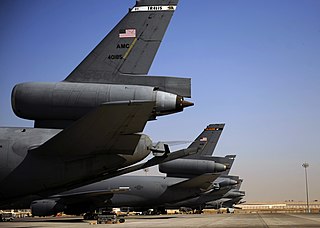
The 908th Expeditionary Air Refueling Squadron is a provisional United States Air Force (USAF) unit. It is assigned to the 378th Air Expeditionary Wing at Prince Sultan Air Base in Saudi Arabia. It has supported combat operations in the War in Afghanistan (2001–2021), Iraq, and Syria from its previous location of Al Dhafra Air Base in the United Arab Emirates. The squadron has a varied background, having been formed by a series of consolidations of no fewer than five distinct units.

